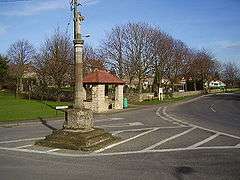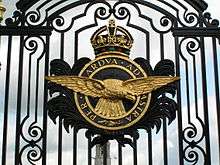Cranwell
| Cranwell | |
 Cranwell village centre, view of the medieval Buttercross base with later addition |
|
 Cranwell |
|
| Population | 2,827 (2011) |
|---|---|
| OS grid reference | TF034502 |
| – London | 105 mi (169 km) S |
| Civil parish | Cranwell , Brauncewll and Byard's Leap |
| District | North Kesteven |
| Shire county | Lincolnshire |
| Region | East Midlands |
| Country | England |
| Sovereign state | United Kingdom |
| Post town | SLEAFORD |
| Postcode district | NG34 |
| Dialling code | 01400 |
| Police | Lincolnshire |
| Fire | Lincolnshire |
| Ambulance | East Midlands |
| EU Parliament | East Midlands |
| UK Parliament | Sleaford and North Hykeham |
|
|
Coordinates: 53°02′12″N 0°27′43″W / 53.0367°N 0.4619°W
Cranwell is a village in the North Kesteven district of Lincolnshire, England. It is part of the civil parish of Cranwell and Byard's Leap and is situated approximately 3 miles (5 km) north-west from Sleaford and 14 miles (23 km) south-east from the city and county town of Lincoln. The principal through road, the B1429 between the A15 to the east and the A17 to the west, joins the village to RAF Cranwell. The appropriate civil parish is called Cranwell, Brauncewll and Btyard's Leap with a population of 2,827 at the 2011 census.[1]
History
During the medieval period the parish was originally governed as part of the ancient Flaxwell Wapentake in the North Kesteven division of Lincolnshire. The name Cranwell is thought to mean the spring where cranes are found.
The village centres on the remains of the village cross. The cross is a 14th-century market cross (or Buttercross) from which important matters of public moment were announced. The base, which is original, and the undisturbed ground beneath are listed as a national monument. A later replacement pillar and cross have been added, probably during the Victorian period.
Cranwell manor was held by the Thorold family from the 16th century for over three hundred years. The manor house was demolished in 1816 and the Hall Farm's farmhouse was erected on the site. The Thorold family relocated to a new mansion at Syston Park. In 1871 Sir John Thorold is recorded as owning all the land in Cranwell with the exception of the church glebelands and a single farmstead that was under the ownership of St John's College, Cambridge.[2]
In 1682, Sir William and his wife Lady Anne Thorold are recorded as establishing a charity that gave about £8 and 2 shillings per year for the poor, to be distributed on Lady Day (25 March and then considered to be New Year's Day). The parish also benefited from the will of Lady Margaret Thorold who granted £15 a year to apprentice four boys from the village. With the Poor Law Amendment Act reforms of 1834, the parish became part of the Sleaford Poor Law Union group of parishes.[3]
The population of the village in 1801 was recorded as being just 88 people and even by 1911 had only risen to 184. The village only grew and has continued to expand since the opening of the aviation training facility and now stands in the region of 3,000 residents.
Cranwell railway station, on a single track branch line from Sleaford, opened in 1917 and served the naval aviation training facility then known as RNAS Daedalus, later to become RAF Cranwell. The branch line was closed in 1956 and the track removed. However, the original station building still stands and is in use as the current RAF main guardroom. Engine sheds in a small goods yard area closer to the village were demolished and the land re-used for housing.
Religious sites
Standing near to the cross is the village's parish church. Dedicated to St Andrew, the church originates circa the 10th century, the village possibly dates from the time of King Alfred (849-899). The church consists only of a nave and chancel with, above the former, a bellcote, much of the masonry is Norman but parts date back to Saxon times. The fittings include 17th century bench-ends and a Perpendicular rood screen.
Mounted on corbels in the north aisle are the remains of a hogsback grave. The carvings on these stones are either Saxon or Norse (Ringerike). The stones are unique to Lincolnshire and are probably the finest of their type in the country. In the stonework in the porch is the incised outline of a pilgrim's shoe and the year 1728, and on the right-hand door pillar are six carved figures believed to depict ancient May King and Queen ceremonial costumes. The churchyard includes a Commonwealth War Graves Commission cemetery with over 200 military graves.
Education
As early as 1682, Sir William and Lady Anne Thorold funded a charity that provided £3 each year for the education of poor children from within the parish. The first true school built in Cranwell opened in 1850 by public subscription and provided facilities for up to 35 children.
The current Cranwell Primary School is housed in a modern building and has approximately 300 children on the roll between the ages of 4 - 11. The school is a Foundation school and is non-denominational.[4]
There are no secondary schools in the village and children instead travel to Lincoln, Grantham or Sleaford.
RAF College Cranwell

Just over one mile to the west of the village is Royal Air Force College Cranwell, and RAF Cranwell with its two associated airfields. The northern airfield is the older, being used for light aircraft and airships from 1916 and remains as a grassed field used occasionally by gliders and light aircraft. The southern airfield is much larger with two paved runways and abuts the A17 road, this was first used as a flying training base in 1917. The paved runways were built in 1954, to make way for the jet aircraft, Meteor and Vampire.
Cranwell does not have a public house. It does, however, have a members only social club. This dates back to when the cadets training at RAF Cranwell during World War II used to come into the village to try and buy alcohol. The members only club was introduced as a deterrent to them, being only temporary residents in the area they were therefore unable to gain membership. To this day, no pub has ever opened its doors to the public, even though the reasons for not having one have long since become obsolete.[5]
Other uses of the name Cranwell
The surname Cranwell occurs in Buckinghamshire and Essex (at least), it appears in the Domesday Book. A few very small farms and hamlets are named Cranwell in Bucks.
References
- ↑ "Civil parish population 2011". Neighbourhood Statistics. Office for National Statistics. Retrieved 26 April 2016.
- ↑ Thorold Family
- ↑ Charities
- ↑ Cranwell Primary School
- ↑ Cranwell, Brauncewell & Byards Leap Cranwell, Brauncewell and Byards Leap Parish Council
External links
 Media related to Cranwell at Wikimedia Commons
Media related to Cranwell at Wikimedia Commons- RAF Cranwell Home Page
- Location map of Cranwell village
- "Cranwell", Genuki.org.uk. Retrieved 20 July 2011